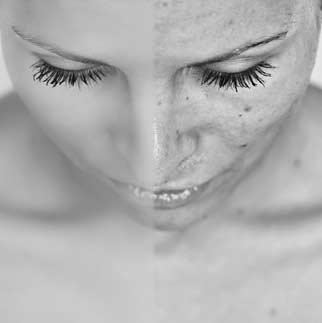Laser treatment for pigmented lesions eliminates brown spots and pigmented lesions on the skin (face, decolletage and hands), which characterize the first signs of skin aging and intensify with sun exposure.
Dr Benjamin Cozanet, an aesthetic medical and laser specialist in Paris, would be pleased to welcome you to his clinic to explain laser treatment objectives through pulsed light (IPL) and how you can make your skin look younger.
Why Use Lasers for Pigmented Lesions and Who is a Good Candidate?

Before the laser for pigmented lesions appeared on the market, the only possible treatment was carbonic snow (liquid nitrogen). Since then, lasers for pigmented lesions have become the best choice to eliminate pigmentation spots.
Laser treatment for pigmented lesions is much more precise because it targets the pigmentation spot without extending beyond the periphery of the spot itself.
Laser treatment for brown spots also results in a rapid scarring process since it only treats the pigmented surface of the skin without going deep into the spot itself.
Before any pigmented lesion laser treatment is chosen, Dr Benjamin Cozanet examines the brown spots and determines which can be treated by laser and which are suspicious spots that should never be touched by laser.
Pigmented lesions are very common in older people, but we can also see them on younger people who have undergone excessive sun exposure.
"Actinic aging" or "heliodermis" is the name given to aging provoked by exposure to sunrays, which are a major factor in premature aging and could even necessitate a photorejuvenation laser treatment at a younger age.
Indications for pigmented lesion laser treatment
Solar lentigines or actinic senile lentigines are the main indications for laser or (IPL) pulsed light laser treatment.
These brown spots which show up on exposed areas, sun-exposed parts: face, neck, decolletage, back side of hands, upper back… and which characterize the first signs of skin aging.
The treatment is optimal on darker spots and milder on lighter spots which contain less melanic pigments.
Another pigmented lesion laser indication is sometimes melasma, but this treatment remains long and uncertain.
This benign skin condition shows up in the form of pigmentary spots mostly on the face, forehead, temples and cheeks. It affects women during pregnancy, frequently referred to as “pregnancy mask”, but which sometimes appears at other times as well. Causes and determining factors are mostly genetic, hormonal (estrogens, pregnancy and use of the birth control pill) and sun exposure.
How Does the Laser for Pigmented Lesions Work?
Pigmented lesion laser treatments work in much the same way as hair removal lasers. The laser produces light in one single color. This light emits energy which specifically targets the pigmented zones. The high melanin concentration allows the laser to concentrate and pulverize the pigmented lesions.
The pigmented lesions can be “erased” by laser in 1 or multiple sessions, depending on the spots. But only certain spots, which have been identified by a dermatologist in advance or by Dr Benjamin Cozanet, can undergo laser treatment. This technique targets both men and women, with phototypes 1-3, avoiding any sun exposure and tanning.
Two types of lasers treat pigmentary brown spots (referred to as 'actinic' or 'solar'): by abrasion or by a photomechanical effect. Ablative lasers remove the skin’s superficial layer containing the pigments causing the brown coloration. A new skin resurfaces, completely spotless, in just 1 week.
Photomechanical lasers pulverize melanin (pigment) in the skin, without any burning or abrasion. The skin containing these pigments will then be eliminated in a scaly thin crust, and fresh and clear skin will then resurface.
Guide to Pigmented Lesion Laser Removal
During your 1st appointment with Dr Benjamin Cozanet, he will perform a traditional check-up to establish a precise diagnosis, setting up a treatment program for the pigmented zones. An information sheet detailing the selected treatment technique and a fully detailed estimate will be provided.
Pre Laser-Session: Avoid all sun exposure, no tanned skin. Don’t apply creams, lotions or perfumes on the targeted zones to avoid all physical light effects on chemical components. Don’t apply makeup to the treatment zone.
During the session, the laser pulses are felt in differing degrees by the patients. The sensation is often likened to a tingling feeling. There are contact anesthetics for these highly sensitive zones if necessary. Lasers generally yield very good and long-lasting results in 1-3 sessions, a minimum of 1 month apart.
Post Laser Treatment and Aftercare
With ablative lasers, a bandage can be applied for the first few days. Localized swelling is common for 3 days. Greasy cream such as petroleum jelly or homeoplasmine ointment is applied for 3-5 days.
With photomechanical lasers, a light scab or crust forms after the session and remains for 1-2 weeks. Spots appear darker at first until the scabs disappear, when the skin regenerates. First it may appear pinkish, then normal coloring will return within a few weeks.
With (IPL) intense pulsed light, like photomechanical lasers, the effect is selective: only the darkly pigmented parts will be treated. The surrounding skin (lighter area) is preserved. The brown spots will darken the next day and progressively lighten in the following 2 weeks.
Sometimes a few thin scabs can form at the site of the former spots and will peel off in about 6 days. You can apply makeup the day after the session.
You must avoid all sun exposure in the month following the treatment and use 50+ sunscreen for the 2 months following the treatment.
How many pigmentary laser sessions are required?
The number of sessions for brown spots depends on the color of the spot.
The darker the spot, the quicker it disappears, usually it only takes one session to erase a dark spot.
Lighter spots disappear progressively in 2-3 sessions, spaced at a minimum of 1 month apart.
Dr Benjamin Cozanet recommends that after the treatment, you use moisturizing creams containing sunscreen, to protect your skin from new spot development.
Top Laser Treatments for Pigmented Lesions
Dr Benjamin Cozanet uses different types of Cynosure® pigmented lesion lasers: the leader in this domain.
2 main types exist: ablative lasers and photomechanical lasers
He can also provide an (IPL) intense pulsed light treatment which also yields excellent results. It’s the operation mode which varies.
Ablative lasers (fractional CO2 laser Multiscan, Cynosure®) remove the superficial layer of the skin (dermabrasion), containing the pigments triggering brown coloration. In fact, the laser destroys a thin layer of superficial skin which stocks the cumulated pigments. A new, spotless skin resurfaces in just a few days.
With photomechanical action lasers: the light energy captures the melanin (brown pigment) in the skin, without burning or abrasion to the superficial skin layer. The pigments are destroyed or fragmented by the emitted energy. Then they can be eliminated by repairing skin cells (macrophage cells that remove foreign bodies from tissues), resurfacing a clearer skin. There are 3 different types:
The Elite laser (Cynosure®), thanks to its dual wavelength (Alexandrite and Nd: YAG) using short pulse durations, allowing the melanin in the spots to be vaporized without causing burns or abrasion.
The Revlite laser (Cynosure®) which is a NdYAG Q-Switched laser, with its ultra short pulse durations which effectively treat a wide variety of pigmented lesions like brown spots, solar lentigos, café au lait spots, melasma, Ota's nevus. Most of these lesions are quickly eliminated with little or no risk of hypopigmentation.
The Picosure laser (Cynosure®) is the first laser in the world to have an ultra-short pulse duration in picoseconds, treating epidermic and dermic pigmentary lesions (solar lentigos, Ota’s nevus), photorejuvenation and color tattoo removal. Its ultra short pulse duration provides maximum effectiveness with a 50% reduction of required sessions and a quicker scar healing process.
With regards to the intense pulsed light (IPL CUTERA), it’s not about a laser with intense pulsed light (high intensity). Here the light energy transforms into heat by acting on the dark pigments in the skin, leading to a selective destruction through a micro burning action. This is about photothermal effects. The destroyed parts are eliminated, a thin scab peels off the skin in the following week.
What Other Possible Solutions Exist to Treat Pigmented Lesions?
Superficial or medium peels can also reduce spots and even out the skin tone. They also improve overall skin texture and can reduce the appearance of fine lines. https://www.eneomey.com/en/75-peels
We can equally use hyaluronic acid injections or Skinboosters on the face, neck, decolletage or to fill hand hollows caused by the loss of skin density and subcutaneous fat melting, making veins and tendons less visible and naturally harmonizing the hands to a younger looking face, for a perfectly natural equilibrium.
To find more about, you can visit websites:
Cryolipolysis CoolSculpting®
EMSCULPT Neo® & EDGE®
Ultherapy Prime®
EMFACE®
Hyaluronic Acid Restylane®
Hyaluronic Acid Juvederm®
SkinBoosters®
Sculptra®
Radiesse®
Peels
or contact Dr Benjamin Cozanet for any questions: Contact Us
or book a first complimentary consultation: Book an Apointment

